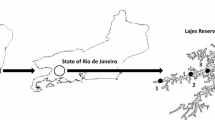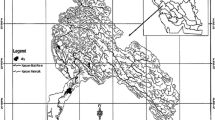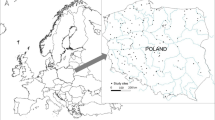Abstract
This chapter addresses the demand of environmental agencies and water industries for tools enabling them to prevent and mitigate events of rapid deterioration of environmental assets such as contamination of air, soils and water, declining biodiversity, desertification of landscapes. Getting access to reliable early warning signals may avoid excessive ecological and economic costs.
Here we present examples of recently emerging technologies for predictive modelling and remote sensing suitable for early warning of outbreaks of toxic cyanobacteria blooms in freshwaters that pose a serious threat to public health and biodiversity. As demonstrated by two case studies, inferential models developed from in situ water quality data by evolutionary computation prove to be suitable for up to 30 days forecasting of population dynamics of cyanobacteria and concentrations of cyanotoxins in drinking water reservoirs with different climates. The models not only forecast daily concentrations of cyanobacteria and cyanotoxins but also daily proliferation rates. Proliferation rates exceeding 0.2 day−1 serve as criteria for early warning. Alarm is triggered if forecasted concentrations of cyanobacteria or cyanotoxins exceed predefined threshold values and proliferation rates exceed 0.2 day−1, constituting a bloom event. Findings from these case studies suggest that cyanobacteria blooms can be forecasted up to 30 days ahead in real-time mode solely based on online water quality data monitored by multi-sensor data loggers.
Advanced remote sensing technology allows to quantify absorption/reflectance characteristics of algal pigments of a water column for deriving chlorophyll-a concentrations as indicator for algal biomass, or discriminating cyanobacteria by specific pigments such as cyano-phycocyanin and cyano-phycoerithrin. It has the potential to monitor spatio-temporal distribution of water quality parameters and cyanobacteria blooms based on sufficient spatial, temporal and spectral resolution of the sensors, and the availability of suitable algorithms to match satellite information with high-resolution in-situ measurements. The chapter discusses the prospect of using remote sensing technology for forecasting seasonal trajectories of cyanobacteria blooms that requires the combination of in-situ monitoring and remote sensing data with hydrodynamic models. By deriving vertical light attenuation in the water column from remote sensing data, hydrodynamic models will be enabled to predict seasonally occurring cyanobacteria blooms.
Access this chapter
Tax calculation will be finalised at checkout
Purchases are for personal use only
Similar content being viewed by others
References
Bouvy M, Falcao D, Marinho M et al (2000) Occurrence of Cylindrospermopsis (Cyanobacteria) in 39 Brazilian tropical reservoirs during the 1998 drought. Aquat Microb Ecol 23:13–27
Briand JF, Robillot C, Quiblier-Lloberas C et al (2002) Environmental context of Cylindrospermopsis raciborskii (Cyanobacteria) blooms in a shallow pond in France. Water Res 36:3183–3192
Cao H, Recknagel F, Orr PT (2014) Parameter optimisation algorithms for evolving rule models applied to freshwater ecosystem. IEEE Trans Evol Comput 18:793–806
Carmichael WW (1994) The toxins of cyanobacteria. Sci Am 270(1):78–86
Cherukuru N, Malthus TJ, Sherman BS et al (2017) Optical response associated with changing summer biogeochemical conditions in a turbid lake. Limnologica. doi:10.1016/j.limno.2017.01.009
Conradie RC, Barnard S (2012) The dynamics of toxic Microcystis strains and microcystin production in two hypertrofic South African reservoirs. Harmful Algae 20:1–10
Dekker AG, Hestir EL (2012) Evaluating the feasibility of systematic inland water quality monitoring with satellite remote sensing, CSIRO, Canberra: Water for a Healthy Country National Research Flagship, 116 p
Dörnhöfer K, Oppelt N (2016) Remote sensing for lake research and monitoring – recent advances. Ecol Indic 64:105–122
Hawkins PR, Runnegar MTC, Jackson ARB et al (1985) Severe hepatotoxicity caused by the tropical cyanobacterium (blue-green alga) Cylindrospermopsis raciborskii (Woloszynska) Seenaya and Subba Raju isolated from a domestic supply reservoir. Appl Environ Microbiol 50:1292–1295
Hestir EL, Brando VE, Bresciani M et al (2015) Measuring freshwater aquatic ecosystems: the need for a hyperspectral global mapping satellite mission. Rem Sens Environ 167:181–195
Huang C, Shi K, Yang H et al (2015) Satellite observation of hourly dynamic characteristics of algae with Geostationary Ocean Color Imager (GOCI) data in Lake Taihu. Rem Sens Environ 159:278–287
Huber V, Wagner C, Gerten D et al (2012) To bloom or not to bloom: contrasting responses of cyanobacteria to recent heat waves explained by critical thresholds of abiotic drivers. Oecologia 169:245–256
Jöhnk KD, Cherukuru N, Anstee J et al (2016) Model-data assimilation framework for harmful algal bloom (CyanoHAB) prediction in inland waters on a continental scale. In: Webb JA et al (eds) Proceedings of the 11th international symposium on ecohydraulics. Melbourne, Australia, 7–12 Feb 2016. The University of Melbourne, ISBN:978 0 7340 5339 8
Klemas V (2012) Remote sensing of algal blooms: an overview with case studies. J Coastal Res 28:34–43
Kudela RM, Palacios SL, Austerberry DC et al (2015) Application of hyperspectral remote sensing to cyanobacterial blooms in inland waters. Rem Sens Environ 167:196–205
Loftin KA, Graham JL, Hilborn ED et al (2016) Cyanotoxins in inland lakes of the United States: occurrence and potential recreational health risks in the EPA National Lakes Assessment 2007. Harmful Algae 56:77–90. doi:10.1016/j.hal.2016.04.001
Lunetta RS, Schaeffer BA, Stumpf RP et al (2015) Evaluation of cyanobacteria cell count detection derived from MERIS imagery across the eastern USA. Rem Sens Environ 157:24–34
Manzo C, Bresciani M, Giardino C et al (2015) Sensitivity analysis of a bio-optical model for Italian lakes focused on Landsat-8, Sentinel-2 and Sentinel-3. Eur J Rem Sens 48:17–32
Matthews MW, Odermatt D (2015) Improved algorithm for routine monitoring of cyanobacteria and eutrophication in inland and near-coastal waters. Rem Sens Environ 156:374–382
Moisander PH, Paerl HW, Zehr JP (2008) Effects of inorganic nitrogen on taxa specific cyanobacterial growth and nifH expression in a subtropical estuary. Limnol Oceanogr 53:2519–2532
Mueller N, Lewis A, Roberts D et al (2015) Water observations from space: mapping surface water from 25 years of Landsat imagery across Australia. Rem Sens Environ 174:341–352
Odermatt D, Giardino C, Heege T (2010) Chlorophyll retrieval with MERIS Case-2-Regional in perialpine lakes. Rem Sens Environ 114:607–617
Orr PT, Rasmussen P, Burford MA et al (2010) Evaluation of quantitative real-time PCR to characterise spatial and temporal variations in cyanobacteria, Cylindrospermopsis raciborskii (Woloszynska) Seenaya et Subba Raju and cylindrospermopsin concentrations in three subtropical Australian reservoirs. Harmful Algae 9:243–254
Palmer SC, Kutser T, Hunter PD (2015) Remote sensing of inland waters: challenges, progress and future directions. Rem Sens Environ 157:1–8. doi:10.1016/j.rse.2014.09.021
Pinardi M, Fenocchi A, Giardino C et al (2015) Assessing potential algal blooms in a shallow fluvial lake by combining hydrodynamic modelling and remote-sensed images. Water 7:1921–1942
Recknagel F, Ostrovsky I, Cao H et al (2014a) Hybrid evolutionary computation quantifies environmental thresholds for recurrent outbreaks of population density. Ecol Inform 24:85–89
Recknagel F, Orr P, Cao H (2014b) Inductive reasoning and forecasting of population dynamics of Cylindrospermopsis raciborskii in three sub-tropical reservoirs by evolutionary computation. Harmful Algae 31:26–34
Recknagel F, Orr P, Bartkow M et al (2017) Early warning of limit-exceeding concentrations of cyanobacteria and cyanotoxins in drinking water reservoirs by inferential modeling. Harmful Algae (in press)
Scheffer M, Bascompte J, Brock WA et al (2009) Early-warning signals for critical transitions. Nature 461:53–59
Stumpf RP, Davis TW, Wynne TT et al (2016) Challenges for mapping cyanotoxin patterns from remote sensing of cyanobacteria. Harmful Algae 54:160–173
Toming K, Kutser T, Laas A et al (2016) First experiences in mapping lake water quality parameters with Sentinel-2 MSI imagery. Rem Sens 8:640
World Health Organisation (WHO) (2003) Guidelines for safe recreational waters. Volume1: coastal and fresh waters. WHO Publishing, Geneva, Switzerland
Wynne TT, Stumpf RP, Tomlinson MC et al (2011) Estimating cyanobacterial bloom transport by coupling remotely sensed imagery and a hydrodynamic model. Ecol Appl 21:2709–2721
Wynne TT, Stumpf RP, Tomlinson MC et al (2013) Evolution of a cyanobacterial bloom forecast system in western Lake Erie: development and initial evaluation. J Great Lakes Res 39:90–99
Ye L, Cai Q, Zhang M et al (2014) Real-time observations, early warning and forecasting phytoplankton blooms by integrating in situ observations, online sondes and hybrid evolutionary algorithms. Ecol Inform 22:44–51
Acknowledgements
Friedrich Recknagel wishes to thank Seqwater (Australia) and RAND Water (South Africa) for making available high quality limnological data of Lake Wivenhoe and Vaal Dam. He also is grateful for the support of his research by the Australian Research Council (Project Number LP0990453).
Author information
Authors and Affiliations
Corresponding author
Editor information
Editors and Affiliations
Rights and permissions
Copyright information
© 2018 Springer International Publishing AG
About this chapter
Cite this chapter
Recknagel, F., Orr, P., Swanepoel, A., Joehnk, K., Anstee, J. (2018). Operational Forecasting in Ecology by Inferential Models and Remote Sensing. In: Recknagel, F., Michener, W. (eds) Ecological Informatics. Springer, Cham. https://doi.org/10.1007/978-3-319-59928-1_15
Download citation
DOI: https://doi.org/10.1007/978-3-319-59928-1_15
Published:
Publisher Name: Springer, Cham
Print ISBN: 978-3-319-59926-7
Online ISBN: 978-3-319-59928-1
eBook Packages: Earth and Environmental ScienceEarth and Environmental Science (R0)




